Watching a Hawaiian play gives me a special way to enjoy local culture, music, and storytelling. I choose a theater or outdoor venue, get tickets early, dress comfortably, and arrive on time to see the whole show.

These plays share Hawaii’s history, traditions, and legends through dance, song, and acting.
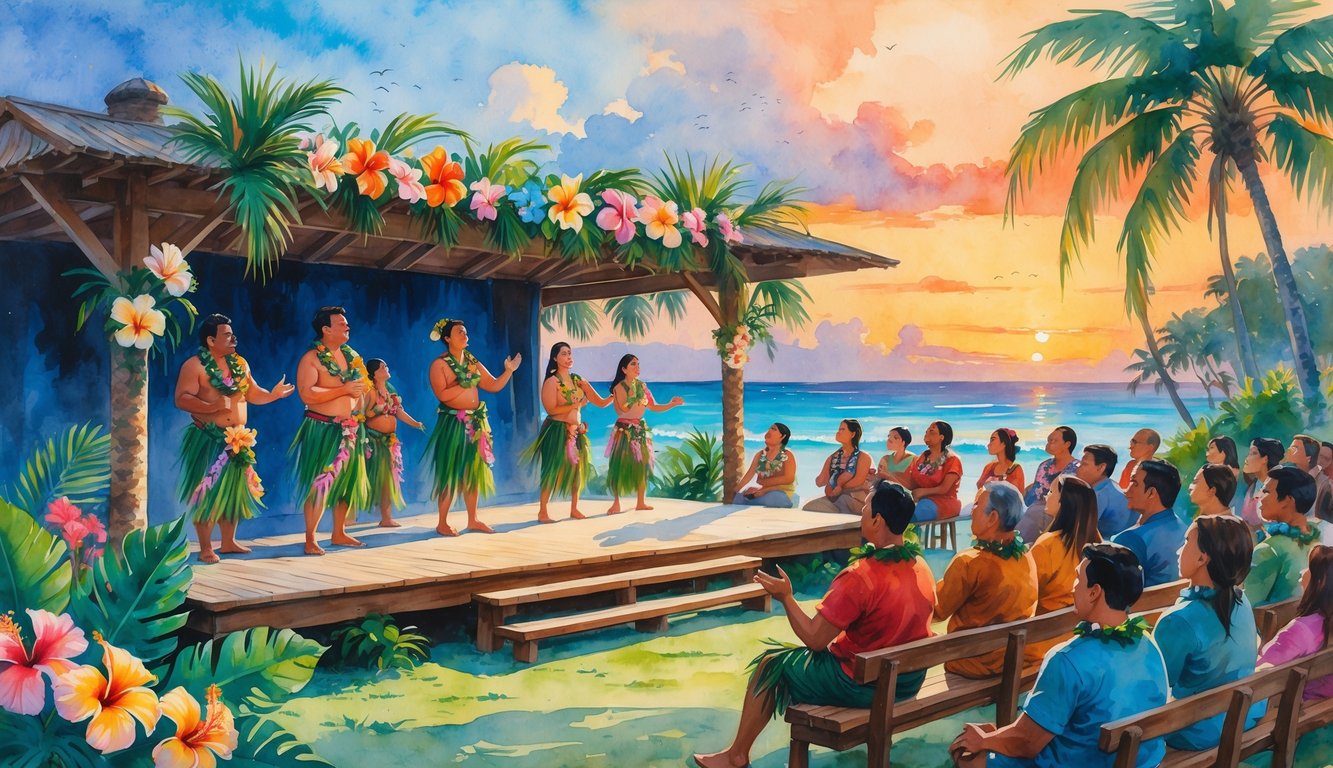
I love watching performers bring old stories to life. The colorful costumes and lively music help me feel the spirit of the islands.
This is a great way to connect with Hawaiian heritage and learn something new during my visit.
What Is a Hawaiian Play?
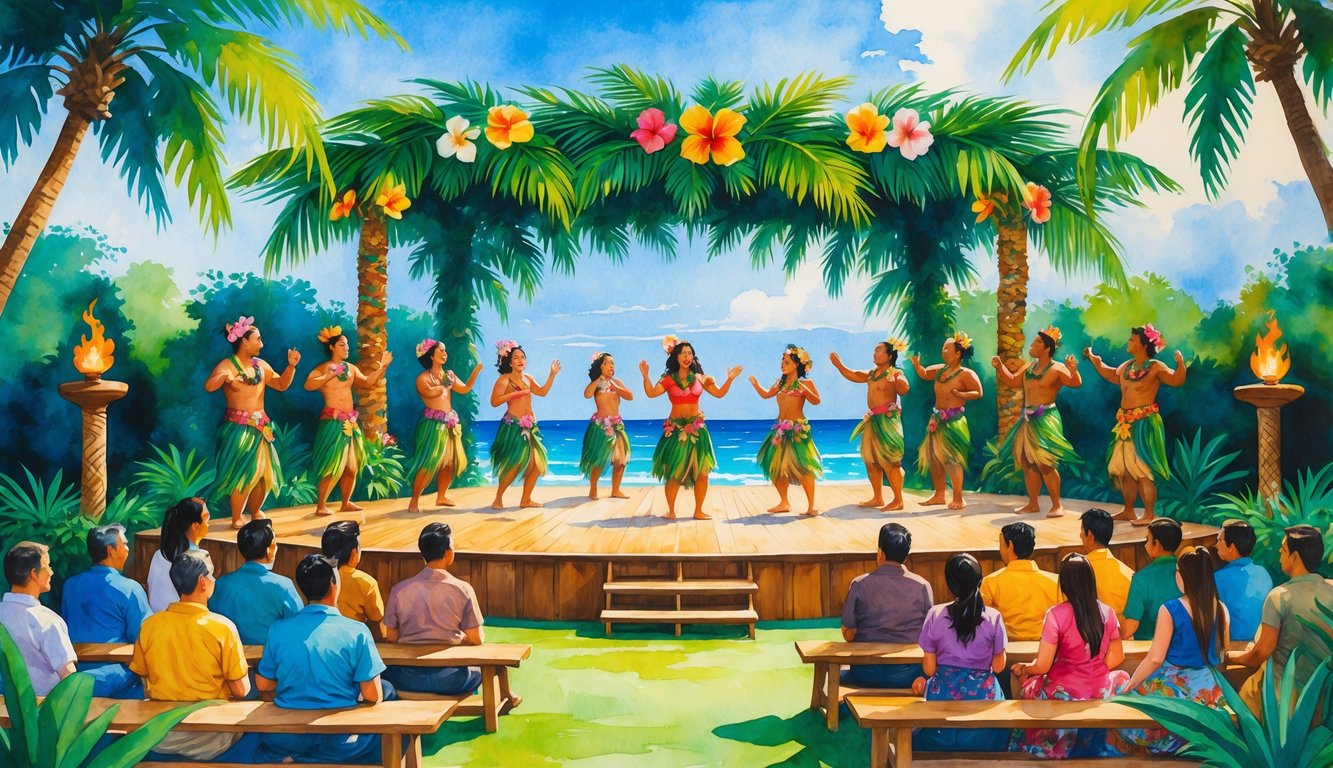
A Hawaiian play lets me step into the heart of island culture through music, dance, and storytelling. I get to see how ancient customs mix with modern traditions to create a lively experience.
Overview of Hawaiian Plays
When I think about a Hawaiian play, I picture a performance that includes more than just acting. It brings together spoken words, traditional music, chants, and dances like hula.
Hawaiian plays often share several stories from legends and real life. The stage bursts with color and movement.
Performers wear bright costumes, flower leis, and grass skirts. Hula uses graceful motions to show meaning and emotion.
Audiences connect with the performance and sometimes join in. Hawaiian plays might stand alone or be part of a larger event like a luau or festival.
Luaus often mix food, games, and performances for a memorable evening. These plays give visitors an authentic Hawaiian cultural experience.
Cultural Significance and History
Hawaiian plays connect deeply with the history and values of Hawaii. For generations, people have used them to pass down stories, values, and beliefs.
Storytelling happens through mele (songs) and oli (chants), which people used before written language. These performances help me see how Hawaiians respect nature, ancestors, and the spirit of aloha.
Plays might share themes of creation, famous chiefs, or personal growth. Dance, music, and traditional language keep the culture alive for everyone.
I find Hawaiian plays not just in theaters, but in parks, on beaches, and at luaus. This shows their importance in daily life and gatherings.
Key Differences from Other Performances
Hawaiian plays use movement and rhythm more than spoken drama. Hula tells stories with gestures instead of many words.
Music and chanting play a big part. Instruments like the ukulele, ipu (gourd drum), and pahu (sharkskin drum) set the mood.
The goal is to teach, bring people together, and honor the past. Audience and performers often interact, so the line between stage and crowd disappears.
Some plays include humor or competition, like in traditional Hawaiian games. Every play keeps storytelling and community at its heart.
How to Find and Choose a Hawaiian Play
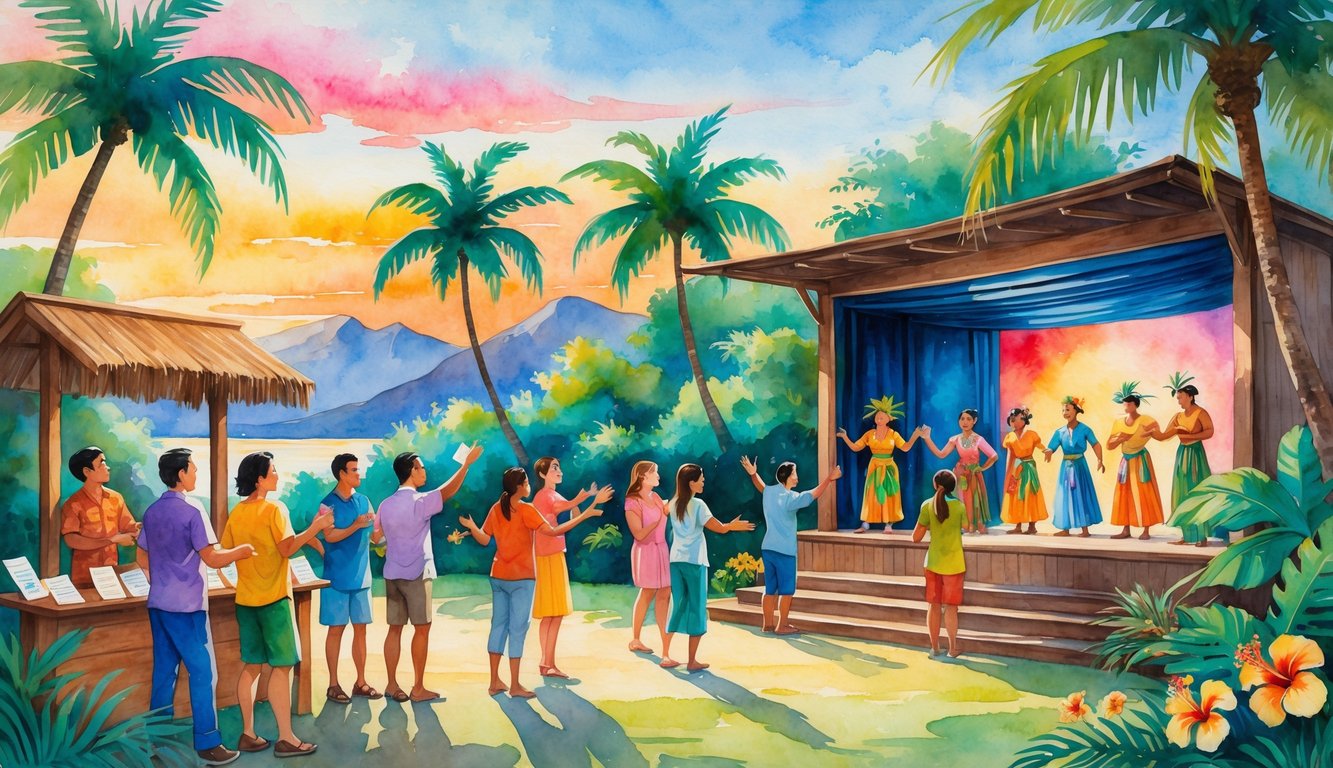
To find the right Hawaiian play, I start by knowing where to look. Each show has its own style, so I check the location, show type, and ticket details.
Popular Venues and Events
I look for Hawaiian plays at major venues that celebrate island culture. The Polynesian Cultural Center on Oahu features evening shows with storytelling, dance, and music.
Paradise Cove and Germaine’s Luau host large luaus with theatrical performances, often right on the beach. Each venue offers its own style, making it easy to find something I like.
Some theaters and resorts put on plays about Hawaiian legends or history. I check event calendars from tourism boards to find unique shows or festival events.
Popular Hawaiian luaus combine dinner, live music, and a cultural play for a full night out.
Types of Performances to Expect
Most Hawaiian plays mix drama, dance, and live music. Authentic luaus show Hawaii’s history through dance and stories of chiefs and legends.
Some plays include fire knife dances, chanting, and traditional songs. Large venues like the Polynesian Cultural Center often feature these elements.
Other plays focus on myths or retell major events from Hawaiian culture. Oahu luaus usually combine several types, giving me a well-rounded experience.
For something more educational, I look for historical plays at smaller theaters. These shows dig deeper into local traditions or historic figures.
Booking Tickets in Advance
Because these shows are popular, I buy tickets early. Big venues like Paradise Cove and Germaine’s Luau often sell out weeks ahead, especially during holidays or summer.
Booking in advance lets me pick my seats and sometimes get a better price. Some places offer packages with dinner and a show together.
If I want a special experience, like a sunset luau or front-row seat, I reserve as soon as possible. Many sites offer online booking with instant confirmation, making it easy.
I always check event details and ticket policies before I buy, so I know what to expect.
What to Expect at a Hawaiian Play
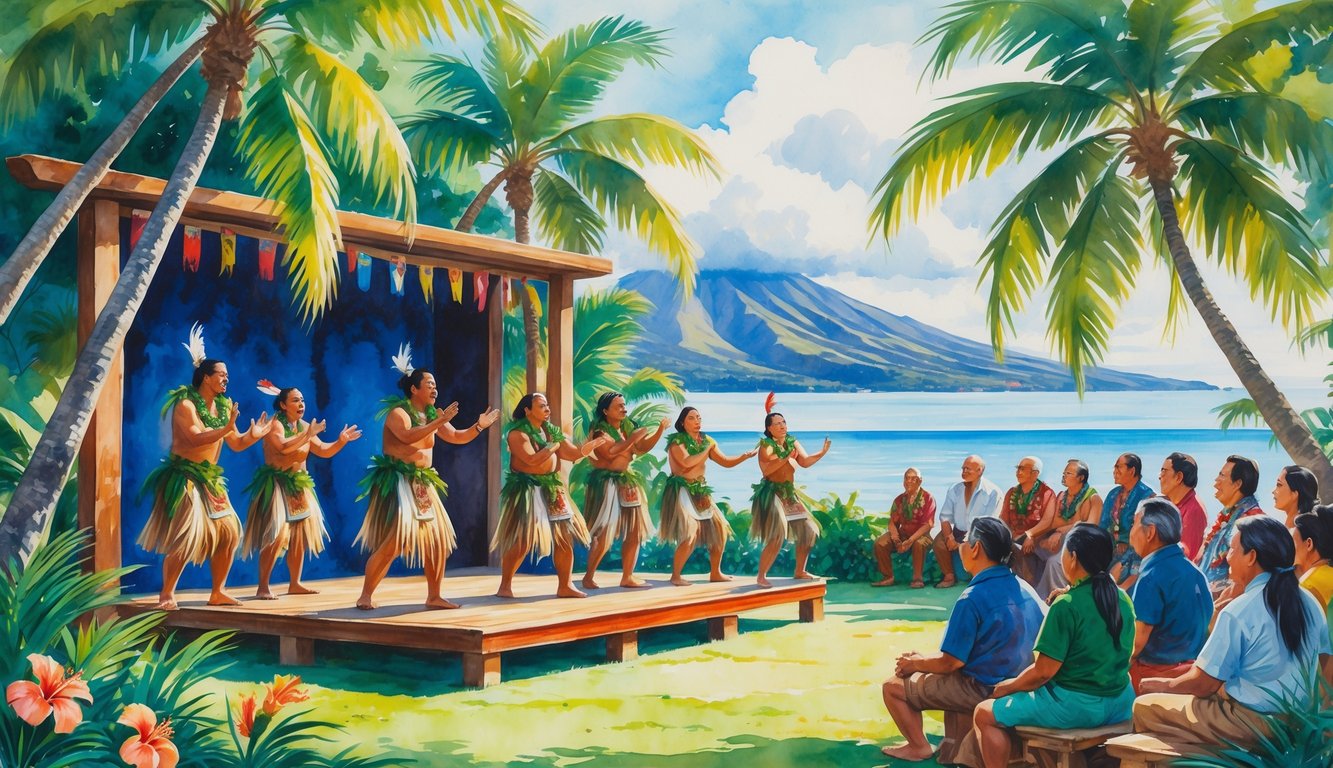
When I attend a Hawaiian play, I see live music, bright costumes, and strong cultural traditions. The event is family-friendly, and guests become part of the ohana, or family, for the evening.
Special ceremonies like the lei greeting welcome everyone warmly.
Typical Schedule and Flow
Most Hawaiian plays follow a clear schedule. When I arrive, I have time to explore the venue and meet other guests.
I often get to watch or join cultural activities. Sometimes, I hear ukulele music or try a simple hula lesson.
These activities help me learn about Hawaiian traditions and add to the fun. Next, the main show starts.
The performance tells a story using traditional dances like hula, original songs, and storytelling. Colorful costumes and lively movement bring legends and history to life.
The play usually lasts two to three hours. This gives everyone time to enjoy each part of the evening.
Greeting and Lei Ceremony
The lei greeting is one of my favorite moments. Staff members give me a lei made from flowers, shells, or kukui nuts as a symbol of aloha and welcome.
If I’m pregnant, I choose an open-ended lei for good luck. The lei ceremony makes everyone feel welcome and honored.
Hosts explain what each lei type means, making the moment special. Being welcomed this way helps me feel the spirit of ohana right from the start.
You can read more about the lei greeting at a Hawaiian play from this guide to attending a Hawaiian luau.
Family-Friendly Atmosphere
Hawaiian plays are great for all ages. Families sit together, and children can join in dancing or simple activities.
Staff and performers interact with kids, making sure everyone feels comfortable. Food is often part of the evening, with dishes for many tastes.
People with dietary needs can enjoy traditional Hawaiian foods too. The friendly hosts make it easy to bring young kids or older family members.
The spirit of ohana fills the event, turning the play into a gathering for new and old friends. For more details on what makes a luau or play welcoming for families, check this complete guide to enjoying a Hawaiian luau with your family.
Experiencing Authentic Hawaiian Culture
When I step into a Hawaiian play, vibrant traditions surround me and tell the stories of Hawaii’s people. Learning about these customs helps me understand the meaning behind each performance.
Cultural Traditions and Etiquette
I see deep respect at every event. People act and dress thoughtfully, following Hawaiian traditions.
For example, I remove my shoes before entering certain places to show respect. People clap at the right times, and talking during a performance is discouraged.
I listen and learn from locals. Sharing food or offering a lei shows welcome and caring.
When someone invites me to join in, I accept politely and thank my hosts.
Storytelling and Interactive Activities
Hawaiian plays blend music and dance to share stories from the past. I watch hula dancers use graceful moves to bring legends to life.
Sometimes, I join hands-on activities, like trying hula steps or making my own lei. These experiences help me connect with the stories.
Drummers, singers, and storytellers invite everyone to join in chants or clapping. This turns the play into a shared experience.
Local guides recommend events that let visitors join cultural performances and try new skills, like those at luaus or cultural centers.
For ideas, I check guides on cultural activities in Hawaii.
Opportunities to Learn About Ohana
The idea of ohana, or family, means more than just blood relatives. It includes friends, neighbors, and anyone who shares in the community.
When I watch a play, I see the cast greet each other warmly and explain the meaning of ohana to the audience. I learn that supporting and caring for each other is at the heart of Hawaiian life.
Many gatherings invite the audience to join group activities, like singing or sharing food. These moments give me a real sense of belonging and togetherness.
Events like luaus and festivals welcome both families and visitors. These celebrations make everyone feel like part of the community, as shown in authentic Hawaiian celebrations.
Hawaiian Entertainment and Performances
Hawaiian plays bring together dancing, music, and live performances. Each part connects to Hawaiian and Polynesian traditions and gives visitors something unique to try.
Hula Dances and Hula Lessons
When I first watch a hula dance, I see how each movement tells a story. Hula is a traditional Hawaiian dance that uses hand gestures, footwork, and swaying hips to share the history and feelings of the Hawaiian people.
Hula dancers perform in colorful costumes, often wearing grass skirts, leis, and flowers. Many events let guests join in by taking a short hula lesson.
This makes it easy for beginners like me to learn simple hula moves in a fun space. Some shows have instructors who break down the basic steps and share the meaning behind each motion.
Dancing hula, even for a few minutes, helps me connect with Hawaiian culture. For more details about how hula dance is featured at these events, visit this guide on Hawaiian hula performances.
Quick Tips:
- Try the lesson if available.
- Focus on hand movements—they carry most of the meaning.
- No experience needed to join in.
Polynesian and Fire Knife Dances
On many nights, the stage lights up with exciting Polynesian dances. Dancers from different Pacific islands, not just Hawaii, perform for the crowd.
The Samoan fire knife dance stands out. Performers spin sharp knives, sometimes lit on fire, in fast circles and toss them high.
The skill and timing in these fire dances always impress me. Shows may also feature traditional Tahitian or Maori dances with unique costumes and fast rhythms.
Sometimes, the audience gets a chance to practice dance moves—without the fire! Both kids and adults cheer and clap along.
Watching these dances, I feel a rush of excitement, especially during the fire knife dance finale. Find more about fire dancing and Polynesian entertainment at luaus and plays.
Performance Highlights:
- Fast drumming and chanting
- Eye-catching costumes
- High energy and crowd interaction
Live Hawaiian Music and Singing
Live music fills the air at Hawaiian plays. Musicians play ukuleles, guitars, and bass, often singing old Hawaiian songs in the Hawaiian language.
Tropical melodies set the mood for the night. Performers encourage the crowd to clap or sing along, making me feel part of the event.
Some nights feature well-known island songs, while others blend in modern tunes. When singers perform traditional mele (songs), they help keep Hawaiian stories alive.
Their voices and the sounds of ukulele make each night memorable. For more about live music at these events, see music and entertainment highlights.
Common Instruments Used:
- Ukulele
- Acoustic guitar
- Bass
- Steel guitar
Hula Performances by Dancers
Skilled hula dancers from local hālau hula (hula schools) perform classic pieces passed down through generations. Their precision and grace bring Hawaiian stories to life.
Hula dancers wear special clothing, such as pa‘u skirts, flower crowns, and colorful sashes. Many dances are performed in groups, with all the dancers moving together.
I can spot both hula kahiko (ancient) and hula ‘auana (modern) styles in most plays. Dancers interact with live musicians, adding even more feeling to the show.
To see details on hula and its place in Hawaiian entertainment, visit information about hula performances by young and adult dancers.
Food and Drinks at the Play
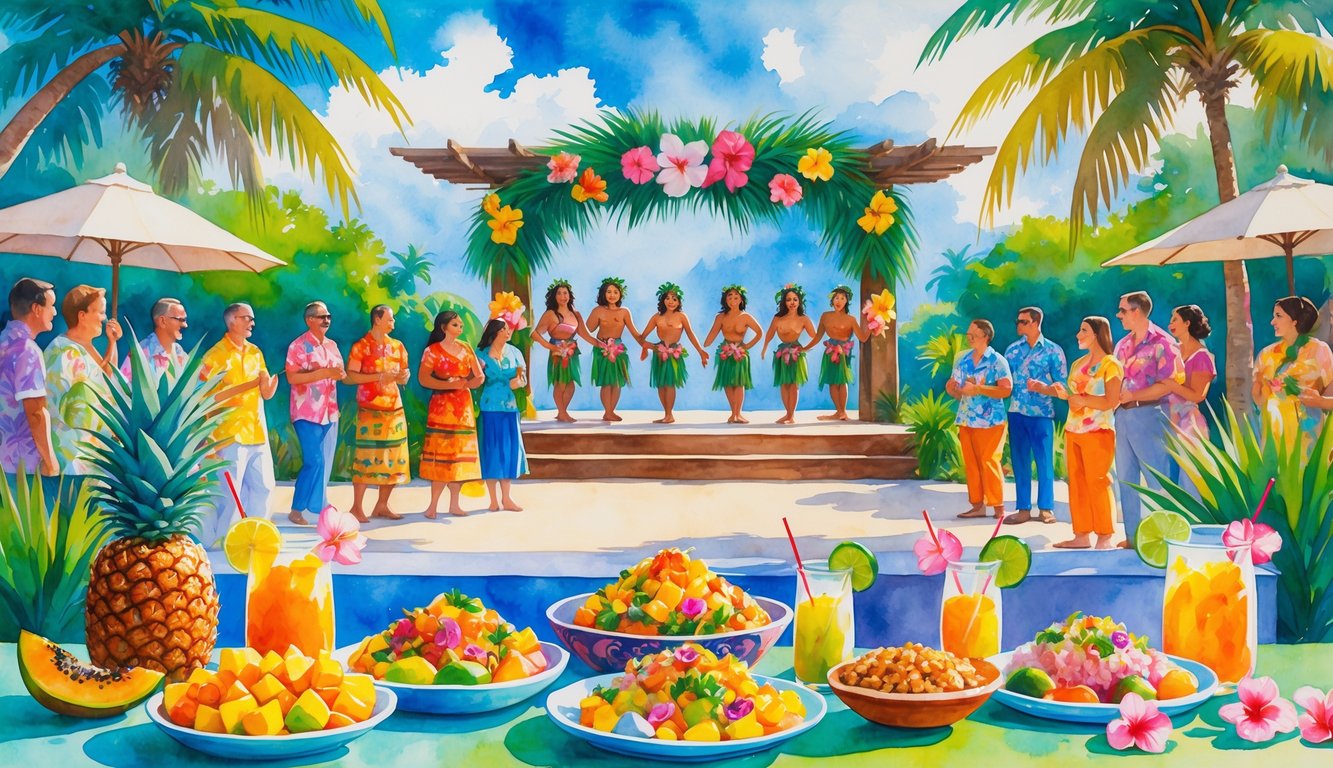
I look forward to trying unique Hawaiian flavors and drinks at the play. From classic dishes like kalua pig to fresh, fruity cocktails, there’s a lot to enjoy.
Traditional Hawaiian Cuisine
At a Hawaiian play or luau, I taste foods that are important to local culture. My favorite is kalua pig, which cooks slowly in an underground oven called an imu.
The pork comes out smoky, moist, and shredded. Other must-try dishes include lomi salmon, a cool salad with fresh fish, tomatoes, and onions.
There’s also poi, a sticky purple paste made by pounding taro root. Poi tastes a bit bland on its own, but it goes well with richer foods.
I often fill my plate with sweet potatoes, sticky white rice, and tropical fruits like pineapple and papaya. These flavors give me a real taste of traditional Hawaiian cuisine.
Buffet Dinner and Luau Feast
The buffet dinner is a highlight at these events. I can choose from a wide variety of local favorites.
Usually, long tables hold roasted meats, grilled fish, and hearty sides. A typical Hawaiian feast includes:
| Main Dishes | Sides & Extras |
|---|---|
| Kalua Pig | Poi |
| Grilled Chicken | Rice |
| Fresh Fish | Sweet Potatoes |
| Lomi Salmon | Tropical Fruit Salads |
It’s easy to go back for seconds or try small portions of everything. Sharing a meal like this with others makes the night feel special and social.
Tropical Drinks and Open Bar
No Hawaiian play is complete without tropical drinks. I like starting with a classic Mai Tai or a fruity piña colada.
The open bar often includes drinks like Blue Hawaiis, lava flows, and sweet mocktails for kids. Bright paper umbrellas and tiki cups make every drink look festive.
Sometimes, I find a station for fresh pineapple juice or coconut water. Bartenders serve both alcoholic and non-alcoholic drinks, so I always find something I like.
This wide selection helps me relax and enjoy the party, sipping something cold as I watch the show and soak up the tropical atmosphere.
Participating in Luau Activities and Games
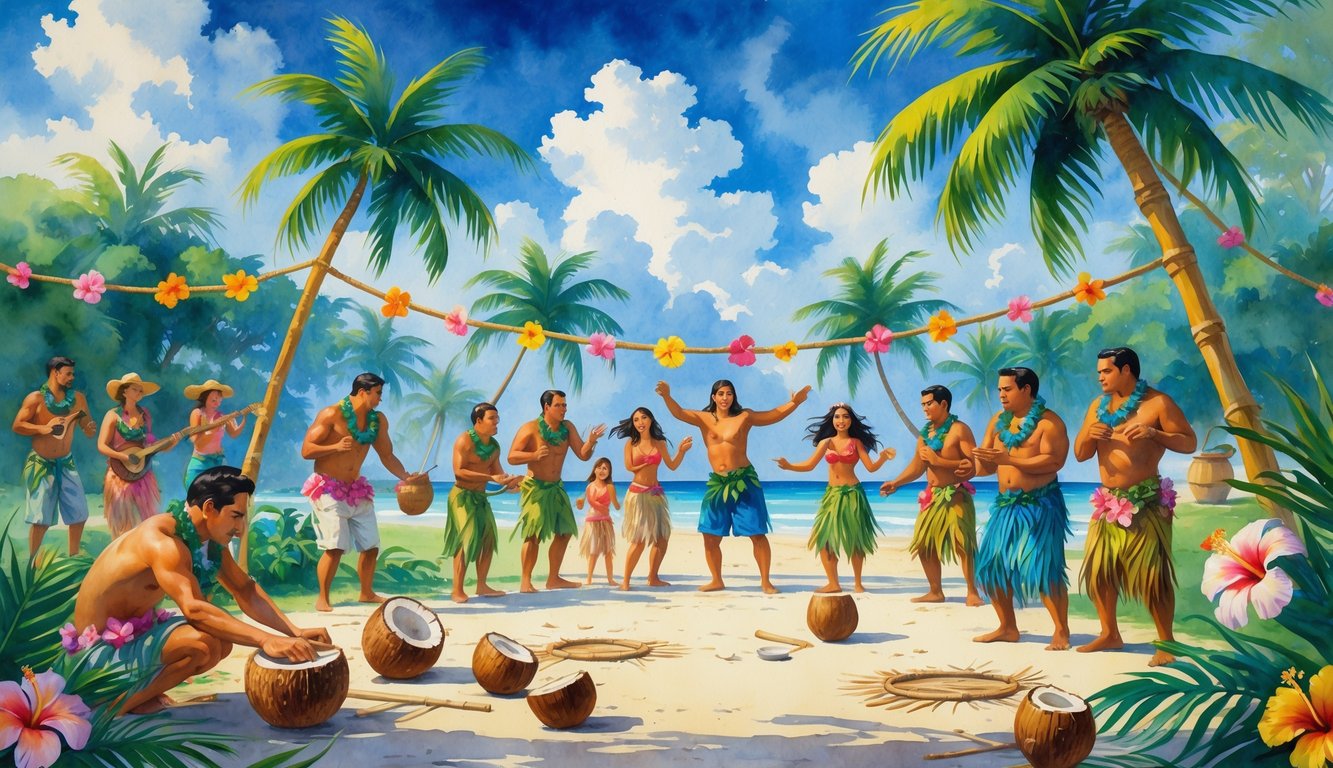
At a Hawaiian luau, I do much more than watch performances. The party includes games, hands-on crafts, and special souvenirs that help me remember the event.
Luau Party Games and Limbo
During the festivities, luau party games get everyone laughing and moving. One favorite is “Pass the Coconut,” which works like hot potato.
We sit in a circle and pass a coconut while music plays. When the music stops, the person holding the coconut leaves the game.
I’ve also played trivia games that test my knowledge of Hawaiian words and traditions. These activities help me meet new people and feel included.
Limbo is another classic luau game. With a limbo pole set up, I try to see how low I can go without falling.
People take turns and cheer each other on, and the pole gets lower after each round. Limbo is fun for both kids and adults and is always a highlight at the party.
For more ideas, I sometimes look up lists of popular luau party games to try at home or at bigger events.
Hands-On Cultural Activities
At some luaus, I try hands-on activities that connect me to Hawaiian culture. Making a flower lei by stringing real flowers together is one of my favorite traditions.
Sometimes, instructors show how to weave a simple bracelet or headband from palm leaves. I’ve also joined ukulele lessons, where teachers show basic chords and encourage everyone to play along.
Hula lessons help me understand the meaning behind each movement. These experiences give me a deeper appreciation for Hawaiian history and tradition.
They also make the event feel more personal. According to some luau guides, these interactive activities are an important part of the night.
Souvenir Shopping and Keepsakes
At every luau, I look forward to finding unique souvenirs. Many parties have small tables or booths with handmade crafts, jewelry, and shirts.
Local artists usually make these souvenirs, which reflect Hawaiian culture. Common keepsakes are shell necklaces, mini ukuleles, and wood carvings.
Sometimes I make my own flower lei and take it home. Small gifts like these help me remember the party long after it ends.
Some places offer craft activities that let me create my own mementos during the event. My favorite part is choosing gifts with friends and family, so everyone has a memory to take home from our Hawaiian luau.
What to Wear and How to Prepare
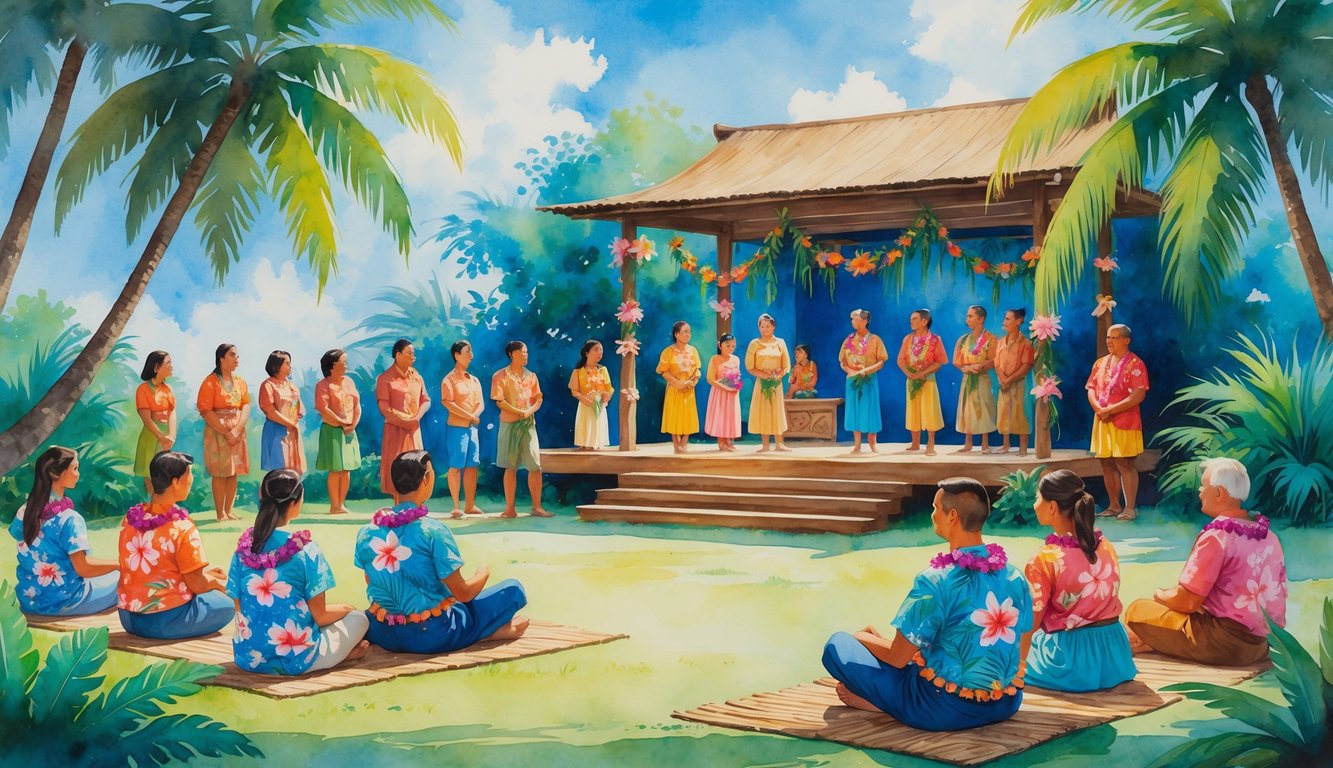
Dressing right and planning ahead make attending a Hawaiian play or luau easier and more enjoyable for me. I keep local customs, the setting, and comfort in mind to have a stress-free time.
Luau Attire Recommendations
When I choose what to wear to a luau or Hawaiian play, I pick bright, tropical-patterned clothes. For men, a classic “Aloha” or Hawaiian shirt is a must-have, often paired with lightweight shorts.
Floral shirts and relaxed dresses work well for women. Muumuus or comfortable sundresses with bold flower prints are always a good choice.
I avoid high heels and wear sandals or flip-flops for a laid-back vibe and easy walking. For a touch of tradition, I like to wear a flower lei or a hair flower clip.
Kids can join in with smaller aloha shirts, shorts, or sundresses that let them play. These touches help everyone fit in and feel part of the authentic luau.
Tips for a Comfortable Experience
I always check the weather before heading out. In Hawaii, temperatures can drop at night.
I bring a light sweater or jacket just in case. I make sure to carry a water bottle to stay hydrated.
I choose loose and breathable fabrics. Luaus and plays can last for hours and sometimes get humid.
I pack sunscreen and apply it before I arrive, especially if the event is outdoors. Sunglasses and a wide-brimmed hat protect me from the sun.
A small bag or backpack holds my belongings like tickets, camera, and extra layers. I charge my electronic devices if I want to capture memories.
Leaving valuables at home gives me peace of mind. This way, I can focus on enjoying the event.
For more on what to bring and wear to a luau or similar event, check out these tips for luau attire.
Making the Most of Your Hawaiian Play Experience
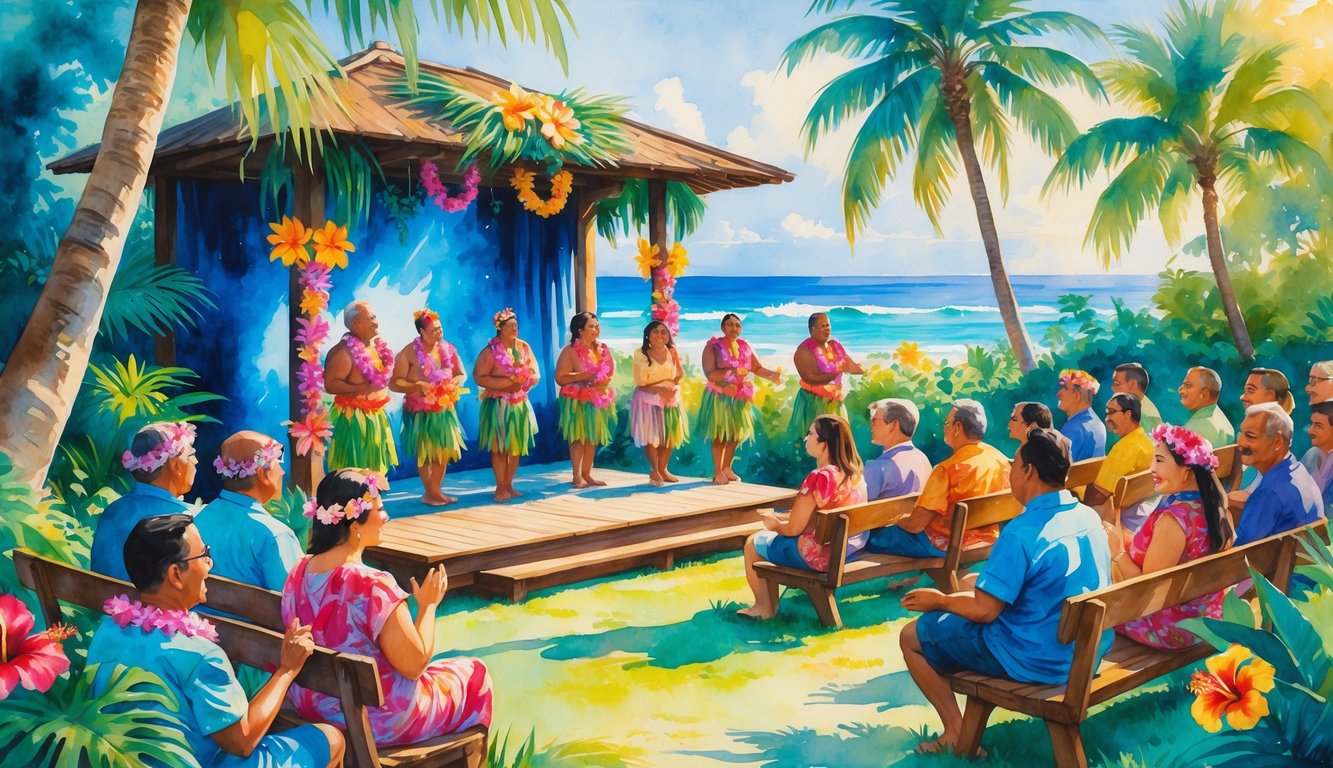
I want to enjoy my Hawaiian play experience and make memories that last. The right approach helps me connect with the culture.
Best Practices for Participation
I always arrive early to find my seat and get comfortable. This helps me settle in before the show starts.
When I attend a cultural experience like a Hawaiian play or a luau experience, I stay present and respectful. Tickets and seats go fast, so I plan ahead whenever I can.
During the show, I silence my phone and avoid talking. I want to respect the performers and other guests.
Many plays invite guests to join simple activities, like clapping or learning a few Hawaiian words. I participate if I feel comfortable.
Trying these activities makes the experience more fun and helps me connect with the story and performers. If food or activities are available, I try them with an open mind.
Hawaiian events often feature traditional food and games. I smile, keep positive energy, and share in the aloha spirit.
Capturing Memories and Photography
I love taking pictures. Before I snap any photos, I always check the rules.
Some Hawaiian plays limit photography to protect the culture or respect the performers. If the play allows photos, I look for special moments like costumes or group scenes.
I keep my camera or phone ready. I never use flash, because it can bother others and distract from the show.
I ask a friend or use a tripod for group shots before or after the play. For close-ups of costumes or decorations, I use the zoom feature instead of moving closer to the stage.
If the play includes hands-on activities or a luau, I take a few photos to remember the experience. I avoid taking photos during quiet parts or special ceremonies out of respect.
I prefer to enjoy the play in the moment. I only take a few pictures so I can remember the experience later.




